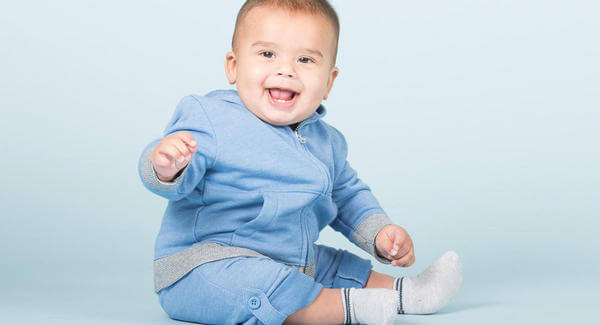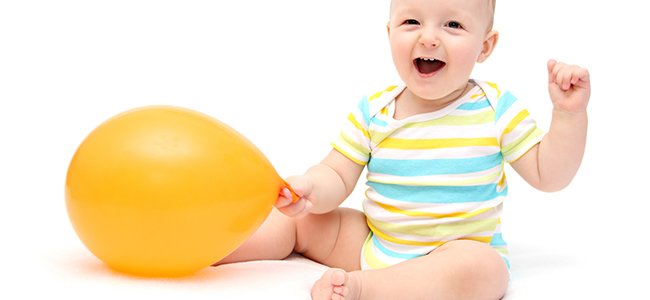When is it safe to sit your baby up?

There’s a common belief that it’s dangerous to sit your baby up when he’s very small. Many sustain that doing so will cause problems for the child’s back.
However, experts affirm that each baby is different. Babies, for the most part, develop at their own rhythm.
Most babies make an effort to try out new movements. There are some positions or postures that cannot be achieved until the baby is able to hold up his head. In most cases, a baby that is 6 months old can roll over on his own and maintain a certain level of stability.
Sitting your baby up isn’t a problem as long as you’re sure you’re not forcing him to maintain the position. To be especially sure, you should wait until your baby is at least 6 months old.
However, we often sit smaller babies up in car seats, strollers, swings, etc. In these instances, it’s important to assure that your baby cannot fall down. You should watch him at all times.
Each baby develops according to his own metabolism. In this day and age, babies are learning much faster than in the past. If a baby sits up on his own, it’s because he can – regardless of his age. Logically, if a baby is uncomfortable in this position, he will immediately shift into a more comfortable posture.
How can I tell if it’s safe to sit my baby up?
In order to tell if your child feels uneasy while seated, it’s important to observe her tension and discomfort. If she’s uncomfortable, she will likely change to a different position. Of course, mainstream baby products are designed to keep your child safe even when seated.

Keep in mind that in order for a child to sit up without problems, she must have already completed the following stages.
- She must be able to roll over while laying down, going from face up or face down, or vise versa
- She must be able to hold her head up straight and maintain the position for some time
- When lying face down, she should be able to push up off the floor with her arms and lift her thorax. For your child, this is like doing mini flexes that strengthen her arms and back
Your child doesn’t require any training. In fact, it’s best to allow her to reach this stage spontaneously. Don’t force it. Carrying out these actions on her own will help to improve her sense of security. It will also help her avoid feelings of anxiety and frustration. Furthermore, not allowing your baby to explore her environment freely may cause her stress.
The safest systems for sitting your baby up
- Ergonomic baby carriers. These baby carriers (wraps, slings, etc) are designed to keep your baby in the correct position without putting stress on his back. Therefore, you don’t need to worry. It’s important to note that you should not place your baby in a backpack baby carrier until he can sit up on his own.
- Car seats. Infant car seats have an curved arch shape that allows your baby’s weight to be distributed in a way that doesn’t harm his back.
- High chairs and booster seats. High chairs and booster seats should not be used until a children can sit up on their own. While they keep your child in a sitting position, they do not keep him aligned. As a result, your baby’s weight falls on the bottom part of his back. Of course, this all depends on your child’s development. Some babies are able to maintain adequate postures and others have a harder time.
Recommendations for sitting your baby up

Once your baby has shown signs of being ready to sit up, you can sit her up for short amounts of time. Remember to always provide neck and back support.
You can sit your child on your lap with her back against your torso. You can also sit her up facing you. Be careful to support her neck and back with your arms and hands.
There is a way to help your child strengthen her neck, back and arms. Simply lay her on her stomach and offer her an object from above. This will encourage her to lift her head and arms to reach it. This should be done only under strict supervision, without forcing her to make any uncomfortable movements.
Very soon, your baby will learn to sit up using the support of her arms on the floor. During this stage, it’s best to set your child down on a rug or mattress. Make sure it’s large and thick enough to protect your child in case she loses her balance. Observe your child to evaluate her strength, and share this special moment together.
All cited sources were thoroughly reviewed by our team to ensure their quality, reliability, currency, and validity. The bibliography of this article was considered reliable and of academic or scientific accuracy.
- American Academy of Pediatrics (2015). Movimiento 4 a 7 meses. Consultado el 16-03-2022. https://www.healthychildren.org/Spanish/ages-stages/baby/Paginas/Movement-4-to-7-Months.aspx
- Comité Nacional de Prevención de Lesiones de la Sociedad Argentina de Pediatría (2016). Consenso sobre mobiliario infantil seguro. Consultado el 16 de octubre de 2023. https://www.sap.org.ar/uploads/consensos/consenso-sobre-mobiliario-infantil-seguro-nbsp2016.pdf
- Lpkin, P., et al. Indicadores importantes: su bebé a los 9 meses. Consultado el 16 de marzo de 2022. https://www.cdc.gov/ncbddd/Spanish/actearly/milestones/milestones-9mo.html
- Pickler, E. (1984). Moverse en libertad. Desarrollo de la motricidad global. Narcea Ediciones. Disponible en: https://books.google.com.ar/books?hl=es&lr=&id=HZA2hjTeEuYC&oi=fnd&pg=PA10&dq=movimiento+libre+pikler&ots=MBHEA2KjvR&sig=_o5jEEp20OHBbb0qTUCdiTJAq7w&redir_esc=y#v=onepage&q=movimiento%20libre%20pikler&f=false
This text is provided for informational purposes only and does not replace consultation with a professional. If in doubt, consult your specialist.
